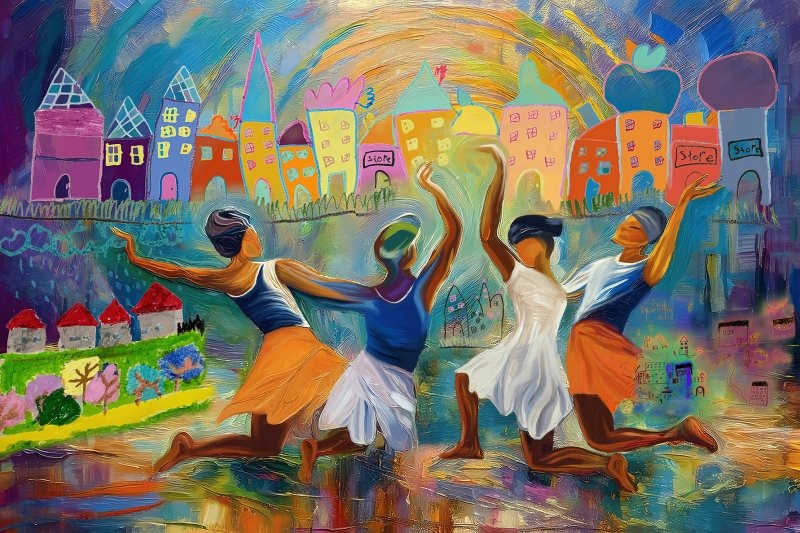Rebecca and I finished the “Moving Elevations” murals at the Citadel+Compagne in Toronto. More details here on MuralRoutes and also on my business site – Future Day
Art
Digital & Abstract Designs
Cyanotypes
I first came across cyanotypes a couple of years ago when I was exploring various techniques for encaustic collage. In addition to embedding photographic images and natural materials, I discovered this photographic process that creates Prussian blue monochromatic prints, developed in the mid-19th century that harnesses the power of the sun to make detailed prints from virtually any object that casts a shadow. These images can be imprinted on fabric, water colour paper, wood and then enhanced with paints or left as is with the monochromatic blue /white impressions.
For those who have not heard of cyanotypes, here’s some background (excerpts from wiki) and a few of my samples follow:
- An image can be produced by exposing sensitised paper to a source of ultraviolet light (such as sunlight) as a contact print.
- After exposure, the paper is developed by washing in cold running water: the water-soluble iron(III) salts are washed away. The parts that were exposed to ultraviolet turn blue as the non-water-soluble Prussian blue pigment remains in the paper. This is what gives the print its typical blue color. The blue color darkens upon drying.
- The simplest kind of cyanotype print is a photogram, made by arranging objects on sensitised paper. Fresh or pressed plants are a typical subject but any opaque to translucent object will create an image. A sheet of glass will press flat objects into close contact with the paper, resulting in a sharp image. Otherwise, three-dimensional objects or less than perfectly flat ones will create a more or less blurred image depending on the incidence and breadth of the light source.
- (from Greek, “Dark Blue”, + “Impression/Mark”)
- Uses two chemicals: – Part A: Potassium Ferricyanide—A red iron salt and Part B: Ferric Ammonium Citrate—A light-sensitive iron salt
- Discovered by Sir John Herschel who in 1842 published his investigation of light on iron compounds
- Anna Atkins, a friend of the Herschel family, over 1843–61 and with the assistance of Anne Dixon, hand-printed several albums of botanical and textile specimens, especially Photographs of British Algae: Cyanotype Impressions,[9] effectively the world’s first photographically-illustrated books
Products available online to produce cyanotypes:
Jacquard
https://www.jacquardproducts.com
https://www.jacquardproducts.com/cyanotype
Kit includes solution, paper, etc
Pre treated sheets
Fluid Art
Acrylic Paint Pouring or Fluid Art involves mixing acrylic paint with a pouring medium (to make the paint flow better) and applying them to canvas or wood using a variety of techniques. This typically does not involve a paint brush, but rather combining colours and pouring them directly onto the canvas and then manipulating the flow, triggering some chemical reactions to stimulate cell creation and lacing, etc. It doesn’t require drawing skills or extensive artistic experience but a natural aptitude with colour and composition will help. It can also be fun and therapeutic. Some artists will enhance/paint over the dried canvas however most of the results are beautiful, abstract pieces as is. Also sometimes employed on smaller pieces is the application of resin to the finished piece.
I started experimenting with this art form during the pandemic and have produced countless pieces. Some examples are shown below.
There are thousands of demonstrations on YouTube of ‘fluid art’ (more high brow term than ‘paint pouring’) and many techniques. Just search for acrylic paint pour on YouTube or instagram and you will see many demonstrations by some great artists.
Notes below summarize some of the techniques used in a workshop we did with our creative club.
Terminology
- Cells
- Lacing
- Cell Activator
- Pouring Mediums, Floetrol, water, silicone oil, etc. will help to dilute the paint and also with some of the chemical reactions
Techniques
- Stretching – when the painting is moved back and forth until the paint has spread over the canvas
- Swiping – using a blade, spatula, wet napkin or plastic sheet to gently spread the paint, often creating cells and lacing and a beautiful flowing pattern
Clean Pour
· Puddle Pour
· Tree Ring / Swirl
· Wing Pour
Dirty Pour
· when all the colours are poured into the cup first and then dumped on the canvas
· Flip Cup
· Bottom Puddle Pour / Flower Pour
Airswipe/Dutch Pour
- Using air, typically a blow dryer (cold air best) or straws, produces interesting, wild and spectacular patterns, which are reminiscent of smoke in the transition to negative colour
- Use one of other techniques (puddle pour or flip cup, etc.) to get paint on canvas, often circle it with the base/negative colour
After the pour and whatever technique is used to move the paint around the canvas:
- Apply heat to break up air bubbles and help form cells
String or Chain pulling techniques to drag paint across the canvas to create some interesting results
Other aids, such as various types of strainers, colanders, steel wool, specialized shapes, balloons, etc. can produce additional effects




















